Description:
Pine trees belong to the genus Pinus, which is part of the Pinaceae family. This genus includes over 120 species of coniferous trees, primarily found in the Northern Hemisphere, with some species in the Southern Hemisphere. Pines are evergreen trees, meaning they retain their needles throughout the year. They vary greatly in size, from small, shrubby trees to tall, majestic ones reaching heights of over 60 meters (200 feet). Pines are easily recognizable by their long, slender needles, arranged in clusters (fascicles), and their woody, cone-shaped reproductive structures.
Common Features:
- Needles: Pine needles are long, thin, and typically grow in bundles of 2 to 5. These needles are often stiff and can range in color from bright green to blue-green. The number of needles in a bundle is a key characteristic used to identify different pine species.
- Bark: Pine bark varies between species but is generally thick and scaly. It can range in color from reddish-brown to gray and often becomes more rugged and furrowed with age, providing the tree with protection against fire and pests.
- Cones: Pine trees produce both male and female cones. The male cones are smaller and produce pollen, while the female cones are larger, woody, and contain seeds. Pine cones can take up to two years to mature and release their seeds, which are often dispersed by wind.
- Growth Habit: Pines have a straight trunk and a conical shape when young. As they mature, the canopy often becomes more rounded or irregular. They typically have deep root systems that help them anchor in sandy or rocky soils.
Role in the Ecosystem:
Pine trees play a crucial role in the ecosystems they inhabit:
- Habitat: Pine forests provide habitat and food for a wide variety of wildlife. Birds, such as woodpeckers and crossbills, and mammals, including squirrels and deer, rely on pine trees for shelter and nourishment. Pine needles and fallen cones contribute to the forest floor, creating a unique microhabitat for insects and fungi.
- Soil Stabilization: Pine trees are often found in sandy or rocky soils, where their deep root systems help to prevent soil erosion. This is particularly important in mountainous regions and coastal areas, where they stabilize the soil and reduce the risk of landslides and dune movement.
- Carbon Sequestration: Like all trees, pines absorb carbon dioxide from the atmosphere and store it in their biomass, helping to mitigate climate change. Pine forests are significant carbon sinks, playing a vital role in reducing the amount of greenhouse gases in the atmosphere.
- Fire Ecology: Many pine species are adapted to fire-prone environments. Some pines have thick bark that protects them from fire, while others rely on fire to open their cones and release seeds, a process known as serotiny. Fire also reduces competition from other vegetation, allowing pines to thrive.
Importance:
- Economic Value: Pine wood is highly valued for its strength, versatility, and availability. It is widely used in construction, furniture making, paper production, and as a source of resin and turpentine. Pine plantations are common, particularly in regions where the wood is harvested for commercial use.
- Cultural Significance: Pines have significant cultural importance in various regions. In many parts of the world, pine trees are used as Christmas trees. Pine wood has been used historically for shipbuilding, construction, and as a symbol of longevity and endurance in different cultures.
- Environmental Importance: Pine forests are vital for maintaining biodiversity and ecological balance. They support a variety of species and are important for water regulation, soil preservation, and as carbon sinks. Pine trees are also used in reforestation efforts, especially in areas where the soil is poor or degraded.
Interesting Facts:
- The Bristlecone Pine (Pinus longaeva) is one of the oldest living trees on Earth, with some individuals over 4,800 years old.
- The Eastern White Pine (Pinus strobus) was highly valued by British shipbuilders in the 18th century for its tall, straight trunks, which were used as masts for ships.
- Pine nuts, or “pignoli,” are edible seeds from certain pine species and are a common ingredient in Mediterranean and Asian cuisines.
- Some pine species, like the Lodgepole Pine (Pinus contorta), have cones that only open after being exposed to the intense heat of a forest fire.
Sources:
- Royal Botanic Gardens, Kew: Offers detailed botanical information on different pine species and their ecological roles.
- USDA Forest Service: Provides insights into the distribution, uses, and management of pine forests in North America.
- National Wildlife Federation (NWF): Includes information on the role of pine trees in supporting wildlife and maintaining ecosystem health.
- International Union for Conservation of Nature (IUCN): Details the conservation status and threats facing various pine species globally.
- Image Source: cff2.earth.com



